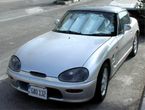Year of Suzuki Cappuccino
Suzuki Cappuccino photos, specs - Car Pictures & Images
 The Suzuki Cappuccino is a small 2-door, 2-seater hard top roadster produced by Suzuki Motor Corporation. The vehicle was designed to meet Kei car specifications for lower tax and insurance in Japan. Weighing just 700kg (1543lb), the Cappuccino is powered by a three-cylinder, all-alloy 657 cc DOHC engine (just under the 660 cc maximum displacement allowed for a Kei car). Its dimensions also conformed to Kei car regulations on length and width, being 3295mm (129.7in) long and 1395mm (54.9in) wide. |
Front-rear weight distribution is claimed to be 50/ 50% when both seats are occupied. Layout is front mid-engined and rear-wheel drive. Three removable roof panels mean that the car can be used as a closed coupé; T-top; targa; or, on retraction of the rear window and roll bar, a full convertible. Roof panels stow in the trunk, and the rear window/ rollcage assembly retracts into the body behind the seats. It was originally equipped with the F6A engine: later models were fitted with a K6A engine which was lighter and had chain-driven, rather than belt-driven, camshafts and more torque. Both are DOHC 12-valve, inline 3-cylinder engines that were turbocharged and intercooled. Power output was a claimed 63hp (47kW) for Kei car purposes. The Cappuccino featured 4-wheel disc brakes, possibly the first production iteration of electric power-assisted steering, aluminium double wishbone suspension and rear wheel drive. Production began in 1991 and ceased in 1997. The Cappuccino's closest competitor of the time were the Autozam AZ-1, Honda Beat and the Daihatsu Leeza Spyder. (The Autozam AZ-1, Honda Beat and Suzuki Cappuccino were together called the Sporty K-Car's ABC.) The early daysThe dream of re-creating a sporting image for Suzuki began in 1987 and within two years the "project car" was shown for the first time at the Tokyo Motor Show. Suzuki intentionally designed the Cappuccino just for the Japanese market, meeting the tax needs of the K-class: body length less than 3.3metres (129.9in), body width not exceeding 1.4metres (55.1in) and engine size less than 0.66 litre. There was never any intention to export the Cappuccino. Production of the Cappuccino started in October 1991 at the Kosai Plant. The car had the designation SX306, and the model identification (incorporated in the VIN) EA11R. The sales launch of the Cappuccino was November 1991 in Japan, with the advertising theme: "fulfilling one's dream of owning a stylish and very affordable 2 seater sportscar". The first two years (1991–92) saw 15,113 cars produced and 13,318 (or 88% of production) sold in Japan. » Read More About Suzuki Cappuccino |


